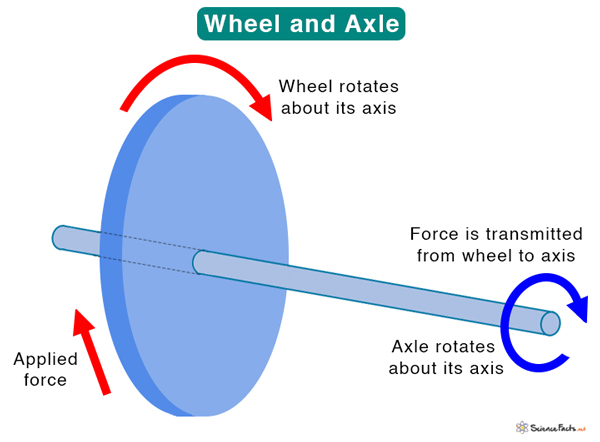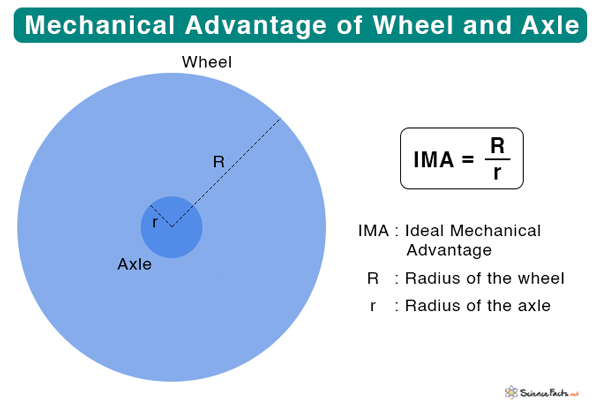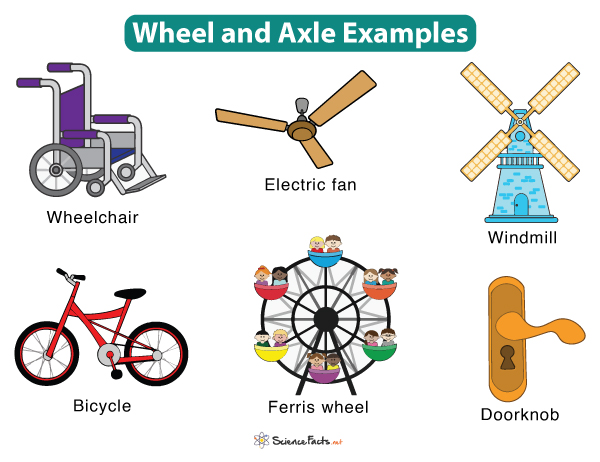Wheel and Axle
What is Wheel and Axle
A wheel and axle is a simple machine consisting of a round disc and a long rod. The disc is known as the wheel, and the rod attached to the wheel is the axle. It executes a rotational motion and is used for many purposes.
Who Invented the Wheel and Axle
Archeological evidence shows that the first wheel and axle existed in Mesopotamia during the Bronze Age around 3500 B.C.
How Does Wheel and Axle Work
Wheel and axle operates through rotational motion by utilizing the principle of torque and angular momentum. The torque, also known as moment of force, is the product of the force and distance from the central axis. The input force is applied either on the wheel or axle and transmitted from one part to the other. The two parts rotate at the same rate. Due to a difference in their circumferences, the distance they rotate in the same amount of time is different. The image below shows a wheel and axle when the force is applied to the wheel.
Mechanical Advantage of Wheel and Axle
Wheel and axle provides leverage that is measured by the mechanical advantage. The mechanical advantage indicates how much the machine performs against the applied force. Generally, the force applied at the axle’s edge is greater than at the wheel’s edge. For wheel and axle, the ideal mechanical advantage (IMA) is given by,
IMA = R/r
Where,
R: Radius of the wheel
r: Radius of the axle
For the equation, it is clear that more mechanical advantage can be gained when the wheel is large. Therefore, by varying the radii of the wheel and the axle, any amount of mechanical advantage can be achieved.
The radius of the wheel can be thought of as the effort arm of a lever. The longer the effort arm, the higher is the mechanical advantage.
Types and Examples of Wheel and Axle
There are two basic kinds of wheel and axle discussed below with examples in real and everyday life.
1. Force Applied on the Axle
In this type, the force is applied to the axle and transmitted to the wheel, rotating rapidly.
Examples: Bicycle, car tires, Ferris wheel, electric fan, analog clock, and winch
2. Force Applied to the Wheel
In this type, the force is applied to the wheel, causing it to rotate. The wheel applies a greater force on the axle, which then rotates over a shorter distance than the wheel.
Examples: Screwdriver, drill, windmill, water wheel, doorknob, pizza cutter, and skateboard
Applications of Wheel and Axle
The wheel and axle has many practical applications in daily life.
- Motor vehicles run on them
- Windmill mills grains using them
- Water turbine uses them to generate electricity
- Clay potters use them to make clay
- Construction crane uses them to lift objects
- Screwdriver uses them to drive a screw into a surface
- Doorknob operates on them to open a door
- A bicycle uses them to move forward
- Ferris wheel uses them as a means of entertainment
- An electric fan runs on them
- Wheels with teeth, known as gears, are used in many machines in a factory
FAQs
Ans. A pulley consists of a wheel over which a rope loops. It rotates as the rope is pulled. The wheel and axle system rotates when a force is applied to the wheel or axle. This force is then transmitted from one part to another.
Ans. The wheel and axle is similar to a lever. The input force is applied tangentially to the wheel, and the output force is applied on the axle. A hinge between the two can be considered as the fulcrum.
-
References
Article was last reviewed on Tuesday, January 18, 2022











Good result
what is a wheel and axle
A wheel and axle is a simple machine that consists of a wheel attached to a smaller axle